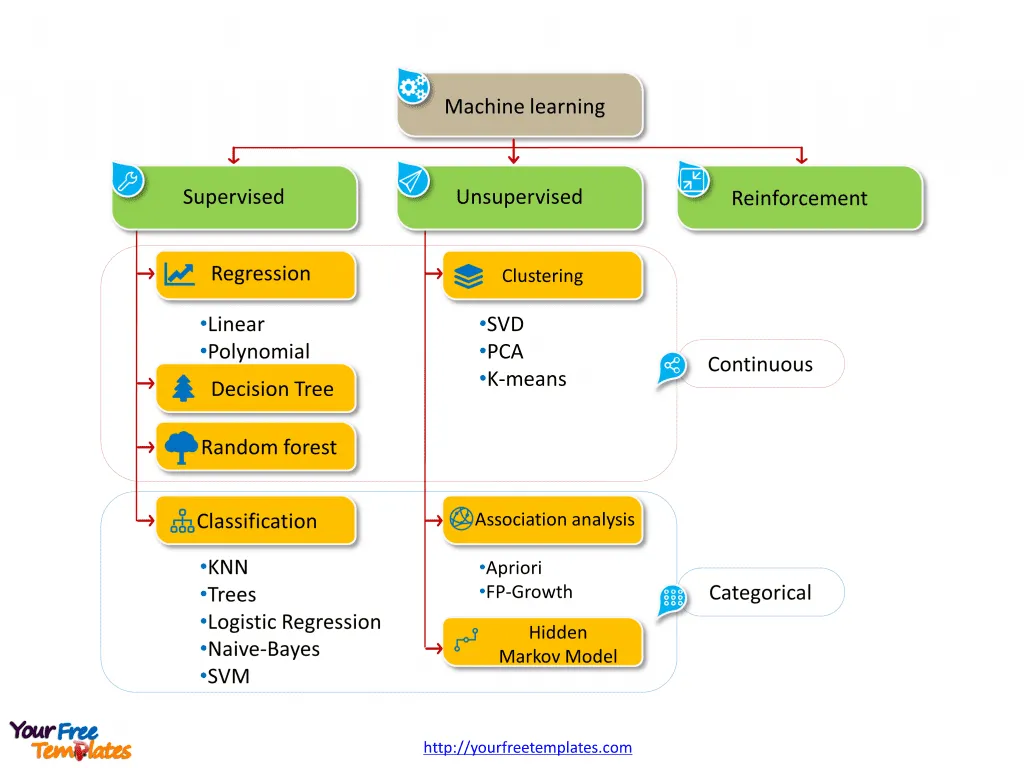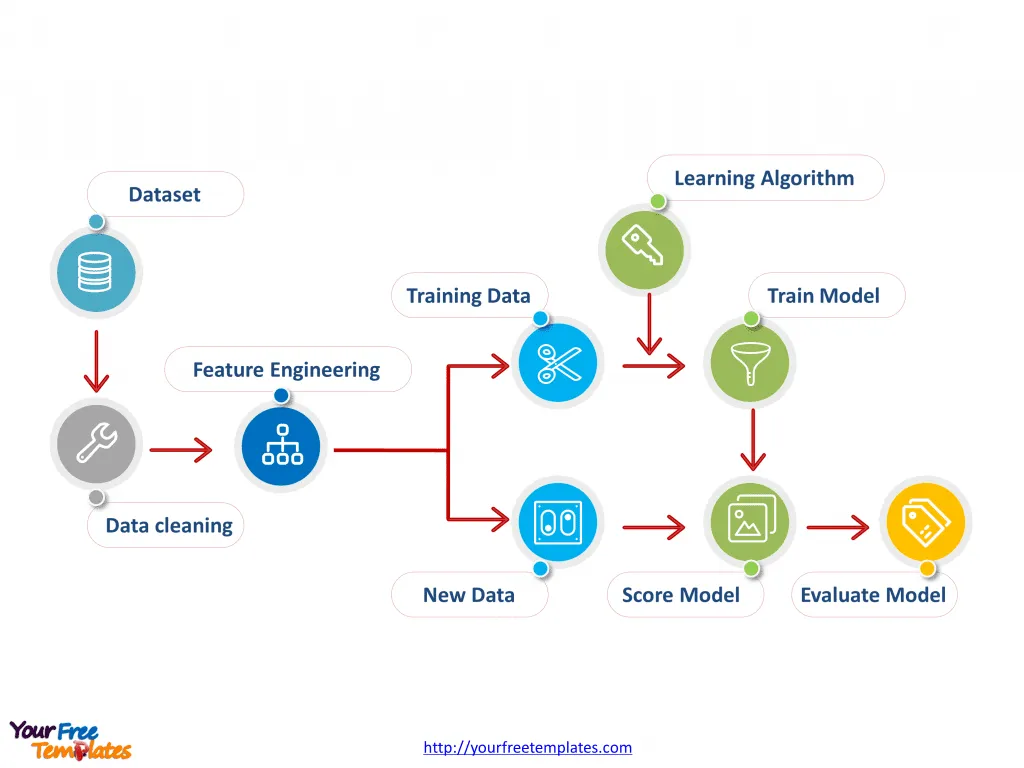The Machine learning Template in PowerPoint format includes two slides. Firstly there are types of the Statistical machine learning. Secondly supervised learning process is the most important one of the Statistical machine learning. So our PowerPoint templates are including supervised learning, unsupervised learning, and Reinforcement learning. Then Supervised learning process diagram shows the detailed steps. You can also have a look at our Data Mining and Artificial Intelligence PowerPoint templates.
Machine learning, a cornerstone of artificial intelligence (AI), empowers systems to learn and improve from experience without being explicitly programmed. It can be broadly categorized into three types: supervised learning, unsupervised learning, and reinforcement learning, each with its unique approach to processing and analyzing data.
Slide 1, Statistical machine learning PowerPoint templates presenting types of machine learning
Supervised Learning is akin to learning with a guide. Here, algorithms are trained on labeled datasets, meaning each input data point is paired with the correct output. The system makes predictions or decisions based on this data and is corrected if its predictions are wrong. Supervised learning is widely used for classification and regression tasks, such as email filtering and predicting house prices.
Unsupervised Learning involves learning without a teacher. Algorithms are left to find structure in their input data without explicit instructions on what to look for. This type is used for clustering and association problems where the goal is to discover hidden patterns or groupings in data. Applications include customer segmentation and genome sequencing.
Reinforcement Learning is learning through trial and error, fundamentally based on the concept of agents taking actions in an environment to achieve some goal. The agent learns to achieve a goal in an uncertain, potentially complex environment. In reinforcement learning, an agent learns to make decisions by receiving rewards or penalties for the actions it takes. This approach has been used in various applications, including game playing, robotics, and navigation systems.

Slide 2, Statistical machine learning PowerPoint templates showing supervised learning process
Supervised learning is a machine learning paradigm that involves learning a function that maps an input to an output based on input-output pairs. It infers a function from labeled training data consisting of a set of training examples. Each example is a pair consisting of an input object (typically a vector) and a desired output value (also called the supervisory signal). The supervised learning algorithm analyzes the training data and produces an inferred function, which can be used for mapping new examples. This detailed process involves several key steps:
1. Data Collection
The first step in supervised learning is the collection of data that will be used for training. This data must be relevant to the problem at hand and include both the input information and the corresponding correct output.
2. Data Preprocessing
Once data is collected, it often needs to be cleaned and converted into a format that the algorithm can process. This may involve handling missing values, normalizing data, encoding categorical variables, and potentially reducing the dimensionality of the data.
3. Splitting the Dataset
The dataset is typically divided into two parts: a training set and a test set. The training set is used to train the model, while the test set is used to evaluate its performance. A common split ratio is 80% for training and 20% for testing.
4. Model Selection
Choosing the right algorithm for the problem is crucial. Different types of problems require different types of models. For example, decision trees, support vector machines, and neural networks are popular choices for classification problems, while linear regression models might be chosen for regression problems.

5. Training the Model
During training, the machine learning algorithm iteratively adjusts its parameters to minimize a loss function. This process involves feeding the input data through the model, comparing the model’s prediction with the actual output, and adjusting the model in a way that makes its predictions more accurate.
6. Evaluation
After training, the model’s performance is evaluated using the test set. Metrics such as accuracy, precision, recall, and F1 score are used for classification problems, while mean squared error or mean absolute error might be used for regression problems.
7. Parameter Tuning and Optimization
Based on the performance on the test set, the model’s parameters may need to be tuned. This can involve adjusting learning rates, the complexity of the model, or other parameters specific to the chosen algorithm.
8. Deployment
Once the model has been trained and evaluated satisfactorily, it can be deployed in a real-world environment where it will receive new, unseen input data and make predictions or decisions based on what it has learned.
The process of supervised learning is iterative and often requires multiple rounds of tuning and evaluation to produce a model that performs well. The key to successful supervised learning is a well-curated dataset, a suitable model for the problem, and careful tuning of the model’s parameters.
At the same time you can also refer to the detailed Machine learning in Wikipedia.
Size:122K
Type: PPTX
Aspect Ratio: Standard 4:3
Click the blue button to download it.
Download the 4:3 Template
Aspect Ratio: Widescreen 16:9
Click the green button to download it.
Download the 16:9 Template














